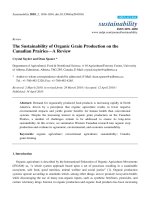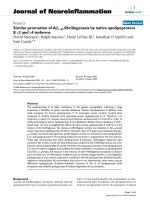- Trang chủ >>
- Khoa Học Tự Nhiên >>
- Vật lý
INFLUENCE OF LASER RADIATION ON THE ABSORPTION OF a WEAK ELECTROMAGNETIC WAVE BY CONFINED ELECTRONS IN DOPED SUPERLATTICES
Bạn đang xem bản rút gọn của tài liệu. Xem và tải ngay bản đầy đủ của tài liệu tại đây (518.34 KB, 6 trang )
Proc. Natl. Conf. Theor. Phys. 36 (2011), pp. 125-130
INFLUENCE OF LASER RADIATION ON THE ABSORPTION OF
A WEAK ELECTROMAGNETIC WAVE BY CONFINED
ELECTRONS IN DOPED SUPERLATTICES
NGUYEN THI THANH NHAN, LE THI LUYEN, NGUYEN QUANG BAU
Department of Physics, College of Natural Sciences, Hanoi National University
NGUYEN VU NHAN
Department of Physics, Academy of Defence force Air force
Abstract. The absorption coefficient of a weak electromagnetic wave by confined electrons in
the presence of laser radiation in doped superlattices (DSL) is calculated by using the quantum
kinetic equation for electrons. The analytic expressions of the absorption coefficient of a weak
electromagnetic wave (EMW) in the presence of laser radiation field for the case of electron optical
phonon scattering are obtained. The dependence of the absorption coefficient on the intensity E01
and frequency Ω1 of the external laser radiation, the intensity E02 and frequency Ω2 of the weak
electromagnetic wave, the temperature T of the system are analyzed. The results are numerically
calculated, plotted, and discussed for n-GaAs/p-GaAs doped superlattices. The appearance of a
laser radiation causes surprising changes in the absorption coefficient. All the results are compared
with those for the normal bulk semiconductors.
I. INTRODUCTION
In recent times, there has been more and more interest in studying and discovering
the behavior of low-dimensional system, in particular, DSL. The confinement of electrons
in these systems considerably enhances the electron mobility and leads to their unusual
behaviors under external stimuli. As a result, the properties of low - dimensional systems,
especially the optical properties, are very different in comparison with those of normal
bulk semiconductors [1-5]. The linear absorption of a weak EMW by confined electron
in low-dimensional systems has been investigated by using the Kubo-Mori method [6-9],
the nonlinear absorption of a strong electromagnetic wave by confined electrons in lowdimensional systems has been studied by using the quantum kinetic equation method [1015]. The problem of influence of laser radiation on the absorption of a weak electromagnetic
wave by free electrons in normal bulk semiconductors has been investigated by using the
quantum kinetic equation method [16]. However, the problem of influence of laser radiation
on the absorption of a weak electromagnetic wave in DSL is still open for study. Research
influence of laser radiation on the absorption of a weak electromagnetic wave have an
important role in experimental. Because in experimental, it is difficult to directly measure
the AC a strong EMW. Therefore, to solve this problem, one study influence of strong
EMW on electrons in semiconductor which is located in the weak electromagnetic waves
[16]. Therefore, in this paper, we study influence of laser radiation on the absorption of
a weak electromagnetic wave by confined electrons in DSL. The electron-optical phonon
scattering mechanism is considered. The absorption coefficient of a weak electromagnetic
126
NGUYEN THI THANH NHAN, LE THI LUYEN, NGUYEN VU NHAN, NGUYEN QUANG BAU
wave in the presence of laser radiation field are obtained by using the quantum kinetic
equation for electrons in a DSL. Then, we estimate numerical values for the specific nGaAs/p-GaAs DSL to clarify our results.
II. THE ABSORPTION COEFFICIENT OF A WEAK EMW IN THE
PRESENCE OF LASER RADIATION FIELD IN A DSL
II.1. The electron distribution function in a doped superlattice
It is well known that the motion of an electron in a DSL is confined and that
its energy spectrum is quantized into discrete levels. We assume that the quantization
direction is the z direction. The Hamiltonian of the electron - optical phonon system in a
DSL in the second quantization representation can be written as:
ωq b+
H=
εn,p⊥ (p⊥ − ec A(t))a+
n,p⊥ an,p⊥ +
q bq +
q
n,p⊥
+
Cq In,n (qz )a+
n ,p⊥ +q⊥ an,p⊥ (bq + b−q )
+
(1)
n,n ,p⊥ ,q
where n denotes the quantization of the energy spectrum in the z direction (n =1,2,...),
(n, p⊥ ) and (n , p⊥ + q⊥ ) are electron states before and after scattering, respectively.
+
p⊥ (q⊥ ) is the in - plane (x,y) wave vector of the electron (phonon), a+
n,p⊥ and an,p⊥ (bq
and bq ) are the creation and the annihilation operators of electron (phonon), respectively.
q = (q⊥ , qz ), A(t) is the vector potential of EMW, and ω0 is the energy of an optical
phonon, Cq is a constant in the case of electron - optical phonon interaction [17]:
Cq
2
=
2πe2 ω0
V ε0 q 2
1
1
−
χ∞ χ0
(2)
Here, V , e, ε0 are the normalization volume, the electron charge and the electronic constant
(often V =1), χ0 and χ∞ are the static and the high - frequency dielectric constants,
respectively.
The electron form factor, In,n (qz ) is written as:
Nd
d
eiqz z ψn (z − ld)ψn (z − ld)dz
In,n (qz ) =
(3)
l=1 0
In DSL, the electron energy takes the simple form:
εn (p⊥ ) =
2 p2
⊥
2m∗
+ ωp n +
1
2
(4)
Here, m∗ is the effective mass of electron, ψn (z) is the wave function of the n-th state for
a single potential well which compose the DSL potential, d is the DSL period, Nd is the
2
1/2
nD
number of DSL period, ωp = 4πe
is the frequency plasma caused by donor doping
χ0 m∗
concentration, nD is the doping concentration.
INFLUENCE OF LASER RADIATION ON THE ABSORPTION...
127
In order to establish the quantum kinetic equations for electrons in DSL, we use
the general quantum equation for statistical average value of the electron particle number
[17]:
operator(or electron distribution function) nn,p⊥ (t) = a+
n,p⊥ an,p⊥
t
i
∂nn,p⊥ (t)
=
∂t
a+
n,p⊥ an,p⊥ , H
(5)
t
ˆ (W
ˆ ψ)
ˆ
where ψ t denotes a statistical average value at the moment t, and ψ t = T r(W
being the density matrix operator). Starting from the Hamiltonian in Eq. (1) and using
the commutative relations of the creation and the annihilation operators, we obtain the
quantum kinetic equation for electrons in DSL:
∂nn,p⊥ (t)
∂t
=−
1
Cq
2
2
In,n (qz )
n ,q
×ei{[(s−l)Ω1 +(m−f )Ω2 −iδ]t+(s−l)ϕ1 }
t
×
dt2
−∞
+∞
2
Jl (a1 q⊥ )Js (a1 q⊥ )Jm (a2 q⊥ )Jf (a2 q⊥ )
l,s,m,f =−∞
i
nn,p⊥ (t2 )Nq − nn ,p⊥ +q⊥ (t2 )(Nq + 1) e [εn (p⊥ +q⊥ )−εn (p⊥ )−
ωq −s Ω1 −m Ω2 +i δ ](t−t2 )
i
+ nn,p⊥ (t2 )(Nq + 1) − nn ,p⊥ +q⊥ (t2 )Nq e [εn (p⊥ +q⊥ )−εn (p⊥ )+ ωq −s Ω1 −m Ω2 +i δ](t−t2 )
i
− nn ,p⊥ −q⊥ (t2 )Nq − nn,p⊥ (t2 )(Nq + 1) e [εn (p⊥ )−εn (p⊥ −q⊥ )− ωq −s Ω1 −m Ω2 +i δ](t−t2 )
i
− n
(t )(N + 1) − n
(t )N e [εn (p⊥ )−εn (p⊥ −q⊥ )+ ωq −s Ω1 −m Ω2 +i δ](t−t2 )
n ,p⊥ −q⊥
2
q
n,p⊥
2
q
(6)
If we consider similar problem but in the normal bulk semiconductors, that authors
V. L. Malevich, E. M. Epstein published, we will see that equation (6) has similarity to
the quantum kinetic equation for electrons in the bulk semiconductor [16].
It is well known that to obtain the explicit solutions from Eq. (6) is very difficult. In
this paper, we use the first - order tautology approximation method to solve this equation
[17-19]. In detail, in Eq. (6), we choose the initial approximation of nn,p⊥ (t) as:
n0n,p⊥ (t2 ) = n
¯ n,p⊥ , n0n,p⊥ +q⊥ (t2 ) = n
¯ n,p⊥ +q⊥ , n0n,p⊥ −q⊥ (t2 ) = n
¯ n,p⊥ −q⊥
Where n
¯ n,p⊥ is the balanced distribution function of electrons. We perform the integral
with respect to t2 ; Next, we perform the integral with respect to t of Eq. (6). The
expression for the unbalanced electron distribution function can be written as:
nn,p⊥ (t) = n
¯ n,p⊥ −
1
Cq
2
In,n (qz )
−i{[kΩ1 +rΩ2 +iδ]t+kϕ1 }
×
−ε
Js (a1 q⊥ )Jk+s (a1 q⊥ )Jm (a2 q⊥ )Jr+m (a2 q⊥ )
k,s,r,m=−∞
n ,q
×e
+∞
2
n
kΩ1 +rΩ2 +iδ
n
¯ n ,p −q Nq −¯
nn,p⊥ (Nq +1)
⊥
⊥
εn (p⊥ )−εn (p⊥ −q⊥ )− ωq −s Ω1 −m Ω2 +i δ
n
¯ n,p⊥ Nq −¯
nn ,p +q (Nq +1)
⊥
⊥
(p⊥ +q⊥ )−εn (p⊥ )− ωq −s Ω1 −m Ω2 +i δ
where a1 =
eE01
,
m∗ Ω21
a2 =
eE02
,
m∗ Ω22
+
−ε
n
n
¯ n ,p −q (Nq +1)−¯
nn,p⊥ Nq
⊥
⊥
εn (p⊥ )−εn (p⊥ −q⊥ )+ ωq −s Ω1 −m Ω2 +i δ
n
¯ n,p⊥ (Nq +1)−¯
nn ,p +q Nq
⊥
⊥
(p⊥ +q⊥ )−εn (p⊥ )+ ωq −s Ω1 −m Ω2 +i δ
(7)
Nq is the balanced distribution function of phonons, E01
and Ω1 are the intensity and frequency of a strong EMW (laser radiation), E02 and Ω2
128
NGUYEN THI THANH NHAN, LE THI LUYEN, NGUYEN VU NHAN, NGUYEN QUANG BAU
are the intensity and frequency of a weak EMW; ϕ1 is the phase difference between two
electromagnetic waves, Jk (x) is the Bessel function.
II.2. Calculations of the absorption coefficient of a weak EMW in the presence
of laser radiation in a DSL
The carrier current density formula in DSL takes the form:
e
e
p⊥ − A(t) nn,p⊥ (t)
j⊥ (t) = ∗
m
c
(8)
n,p⊥
Because the motion of electrons is confined along the z direction in a DSL, we only consider
the in - plane (x,y) current density vector of electrons j⊥ (t).
The AC of a weak EMW by confined electrons in the DSL takes the simple form
[17]:
8π
j⊥ (t)E02 sin Ω2 t
(9)
α= √
2
t
c χ∞ E02
From the expressions Eqs. (8), (9), we established the AC of a weak EMW in DSL:
α=
n0 ωp e4 ω0
2πχ∞ (m∗ kb T )3/2 ε0 cΩ32
1
χ∞
1
χ0
−
+∞
IIn,n
n,n =−∞
3
× (D0,1 − D0,−1 ) − 21 (H0,1 − H0,−1 ) + 32
(G0,1 − G0,−1 )
1
1
+ 4 (H−1,1 − H−1,−1 + H1,1 − H1,−1 ) − 16 (G−1,1 − G−1,−1
1
(G−2,1 − G−2,−1 + G2,1 − G2,−1 )
+ 64
√
Where:
Ds,m = πe
1/
4
2
ξ
− 2ks,m
T
2
4m∗ ξs,m
b
4
K1
/2
ξ
Hs,m =
a21
π
2
+
π
4
cos 2γ e
− 2ks,m
T
b
ξ
Gs,m = a41
3π
8
+∞
IIn,n =
+
π
4
cos 2γ e
2
− 2ks,m
T
b
In,n (qz ) dqz ; Nω0 =
−∞
|ξs,m |
2kb T
2
2
4m∗ ξs,m
4
2
2
4m∗ ξs,m
4
− kεnT
e
3/
4
b
(Nω0 + 1) − e
K3
/2
5/
4
K5
/2
|ξs,m |
2kb T
|ξs,m |
2kb T
e
(10)
+ G1,1 − G1,−1 )
−
εn −ξs,m
kb T
− kεnT
e
b
−
(Nω0 + 1) − e
− kεnT
b
Nω0
εn −ξs,m
kb T
−
(Nω0 + 1) − e
Nω0
εn −ξs,m
kb T
1
ω0
e kb T
−1
ξs,m = ωp (n − n) + ω0 − s Ω1 − m Ω2 , with s = - 2, - 1,0,1,2; m= -1,1
γ is the angle between two vectors E01 and E02
III. NUMERICAL RESULTS AND DISCUSSION
In order to clarify the mechanism for the absorption of a weak EMW in a DSL
in the presence of laser radiation, in this section, we will evaluate, plot, and discuss the
expression of the AC for the case of a doped superlattice with equal thickness dn = dp of
the n- and p- doped layers, equal and constant doped concentration nD = nA : n-GaAs/pGaAs [20]. The parameters used in the calculations are as follows [9,17]: χ∞ = 10, 9,
χ0 = 12, 9, m = 0, 067m0 , m0 being the mass of free electron, d = 80nm, n0 = 1023 m−3 ,
nD = 1023 m−3 , ω0 = 36, 25meV , γ = π3
Nω0
INFLUENCE OF LASER RADIATION ON THE ABSORPTION...
Fig. 1. The dependence of α on T
(Ω1 = 3 × 1013 Hz, Ω2 = 1013 Hz)
Fig. 3. The dependence of α on Ω2
(T = 90K, Ω2 = 5 × 1013 Hz)
129
Fig. 2. The dependence of α on Ω1
(T = 30K, E01 = 106 V /m)
Fig. 4. The dependence of α on E01
(Ω1 = 6 × 1013 Hz, Ω2 = 3 × 1013 Hz)
Figure 1 show that when the temperature T of the system rises up from 30K to
400K, its absorption coefficient reduce, then gradually increase to 0.
Figure 2 show that when the frequency Ω1 rises up, absorption coefficient speeds up
too, then gradually reduce to a certain value, and curve has a maximum value.
Figure 3 show absorption coefficient as a function of the frequency Ω2 of weak EMW.
This figure shows that the curve has a maximum where Ω2 = ω0 ; with Ω1 = 1013 Hz, the
curve has more than one maximum.
Figure 4 show absorption coefficient as a function of the intensity E01 of laser radiation. This figure shows that the curve can have maximum or no maximum in the surveyed
interval.
These figures show that under influence of laser radiation, absorption coefficient of a
weak EMW in a DSL can get negative values. So, by the presence of strong electromagnetic
waves, in some conditions, the weak electromagnetic wave is increased. This is different
from the case of the absence of laser radiation.
130
NGUYEN THI THANH NHAN, LE THI LUYEN, NGUYEN VU NHAN, NGUYEN QUANG BAU
IV. CONCLUSION
In this paper, we analytically investigated influence of laser radiation on the absorption of a weak EMW by confined electrons in DSL. We obtained a quantum kinetic
equations for electrons confined in DSL. By using the tautology approximation methods,
we solved this equation to find the expression for the electron distribution function. Then,
we found the formula of the AC in DSL. We numerically calculated and graphed the AC
for n-GaAs/p-GaAs DSL to clarify.
ACKNOWLEDGMENT
This research is completed with financial support from the Program of Basic Reseach
in Natural Science-NAFOSTED and QG.TD.10.02.
REFERENCES
[1]
[2]
[3]
[4]
[5]
[6]
[7]
[8]
[9]
[10]
[11]
[12]
[13]
[14]
[15]
[16]
[17]
[18]
[19]
[20]
R. Tsu, L. Esaki, Appl. Phys. Lett. 22 (1973) 562.
J. S. Harris Jr, Int. J. Mod. Phys. B 4 (1990) 1149.
P. Zhao, Phys. Rev. B 49 (1994) 13589.
N. Nishiguchi, Phys. Rev. B 52 (1995) 5279.
R. Dingle, Confined Carries Quantum states in ultra-thin Semiconductor Heterostructures, in Festkorperprobleme XV, H. J. Queisser, Pergamon Vieweg, New York, 1975.
Nguyen Quang Bau, Nguyen The Toan, Chhoumn Navy, Tran Cong Phong, Comm. Phys. 6 (1996)
30-40.
N. Q. Bau, N. V. Nhan, T. C. Phong, J. Kor. Phys. Soc. 42 (2003) 647.
N. Q. Bau, T. C. Phong, J. Phys. Soc. Jpn 67 (1998) 3875.
N. Q. Bau, N. V. Nhan, T. C. Phong, J. Korean. Phys. Soc. 41 (2002) 149-154.
N. Q. Bau, H. D. Trien, Intech: Wave propagation 22 (2011) 461-482.
N. Q. Bau, L. T. Hung, N. D. Nam, J. of Electromagn. Waves and Appl. 24 (2010) 1751-1761.
N. Q. Bau, M. D. Hung, L. T. Hung, Pier Letters 15 (2010) 175-185.
N. Q. Bau, M. D. Hung, N. B. Ngoc, J. Korean. Phys. Soc. 42 (2009) 765-773.
N. Q. Bau, L. T. Hung, H. D. Trien, Intech: Behaviour of electromagnetic waves in different Media
and Structures, 2011 Ali Akdagli Ed., pp. 275-300.
P. Vasilopoulos, M. Charbonneau, C. M. Van Vliet, Phys. Rev. B 35 (1987) 1334.
V. L. Malevich, E. M. Epstein, Izvestria BYZ, RadioPhysic T. 18 (1975) 785-811.
V. V. Pavlovich, E. M. Epstein, Sov. Phys. Solid State. 19 (1977) 1760.
V. L. Malevich, E. M. Epstein, Sov. Quantum Electronic 1 (1974) 1468-1470.
E. M. Epstein, Sov. Communication of HEE of USSR, Ser. Radio 18 (1975) 785.
K. Ploog, G. H. Doller, Adv. Phys. 32 (1975) 285-359.
Received 30-09-2011.









